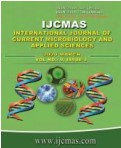


 National Academy of Agricultural Sciences (NAAS)
National Academy of Agricultural Sciences (NAAS)

|
PRINT ISSN : 2319-7692
Online ISSN : 2319-7706 Issues : 12 per year Publisher : Excellent Publishers Email : editorijcmas@gmail.com / submit@ijcmas.com Editor-in-chief: Dr.M.Prakash Index Copernicus ICV 2018: 95.39 NAAS RATING 2020: 5.38 |
Fifty yeast isolates from different habitats nearby a textile factory in Menoufia governerate, Egypt were screened for their ability to decolorize the azo dyes direct red 81 (DR81) and reactive brilliant red X-3B (RBR). Out of those, twenty two isolates displayed positive results therefore they were characterized morphologically and physiologically. The most active two were identified as Meyerozyma guilliermondii and Naganishia diffluens on the bases of 28S ribosomal RNA sequencing. The bio degradation of the dyes was confirmed by UV-visible spectra and IR analysis. The dyes decolorization percentage of 0.01 and 0.005% of DR81 and RBR reached 87.0 and 70.7% by these two yeasts respectively. Sucrose and glucose were the best carbon sources for the two yeasts whereas peptone was the best nitrogen source for both. Incubation at 300C for 48h of shaked culture was the best physical conditions for bio-decolorization process. The results also indicated that pH5 and 7 are the optimum pH values, increasing the concentration of NaCl resulted in a significant decreasing in dye decolorization. Elevated concentrations of Cu+2 or Fe2+ had a significant diverse effect on the ability of M. guilliermondii to decolorize DR81but there was a slight effect of Co2+. On the other hand, there was a non significant effect of Cu2+ and Fe2+ on the activity of N. diffluens towards decolorization of RBR but high concentrations of Co2+ showed inhibitory effects on the biodegradation processes. These results were discussed in relation with their importance in the field of biotechnological application for bioremediation of azo dyes-polluted effluents.
 |
 |
 |
 |
 |